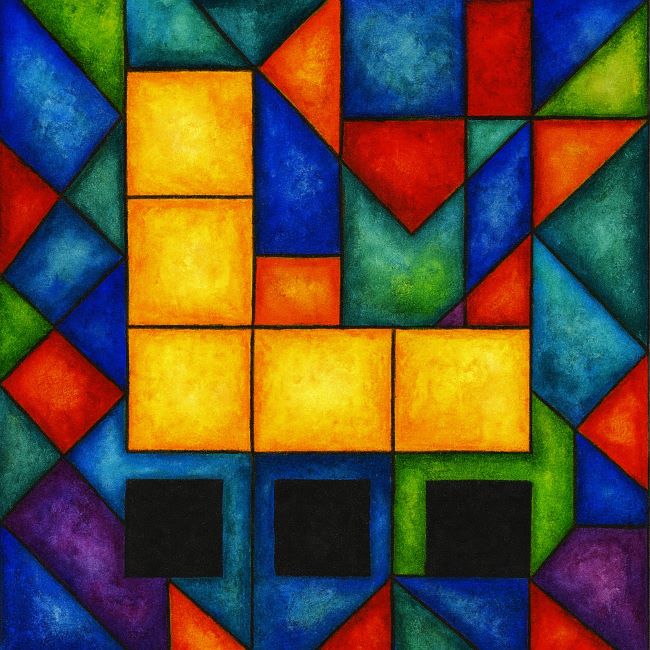| Malta Short Let: Cozy Stay in Gzira | |
|
Sliema Area Modern Designer Finished 2 Bedrooms + Games Room. First floor with Maltese Balcony Large back Terrace with swinging sofa Fully Airconditioned + Full Kitchen 3 TVs, including 65” with backlight. |
 |
|
Book Now: Google Travel | Direct (Cheapest) | Booking.com | Airbnb |
|
How a Minimalist Game by a Maltese Genius Teaches Strategic Mastery
In 1968, Edward de Bono created what might be the world’s simplest strategic game. Using just a 4×4 board and two L-shaped pieces, he designed a game so minimal it could be learned in 30 seconds—yet so deep that no computer has ever solved it completely.
This wasn’t just a game. It was a profound lesson wrapped in play: the most powerful strategies often use the fewest possible elements to achieve maximum effect.
Today, as we drown in complexity—endless features, infinite options, overwhelming choices—de Bono’s L Game offers something revolutionary: a mental model for winning through reduction rather than addition.
Malta knows this truth intimately. With limited land, scarce water, and few natural resources, the island has thrived for millennia not by having more, but by doing more with less. The massive fortifications of Valletta weren’t built with endless resources but with strategic placement of finite stones. Each bastion positioned for maximum defensive value with minimum material.
While de Bono created the game, its core philosophy of thriving through limitation makes it a perfect ‘Maltese Mental Model’—a lens through which we can understand the island’s own strategic genius. This is L Game thinking: achieving strategic dominance through elegant minimalism.
Disclaimer: This article provides an educational analysis of strategic thinking principles derived from Dr. Edward de Bono’s L Game. The L Game and its strategic concepts are his intellectual property. This piece offers commentary and modern applications to encourage readers to explore de Bono’s original work. For the complete game and its philosophy, we encourage purchasing de Bono’s books on game thinking and strategy.
De Bono discovered that strategic thinking isn’t about having more options—it’s about having the right options.
🎮 Understanding the L Game: A Masterclass in Reduction
Before we extract the thinking principles, let’s understand the game itself:
- A 4×4 grid (just 16 squares)
- Two L-shaped pieces (each covering 4 squares)
- Two neutral pieces (single squares each)
- That’s it. The entire game.
The Rules:
- Players take turns moving their L-piece to any new position
- After moving, you may (optionally) move one neutral piece
- You win when your opponent cannot move their L
The Revelation: Despite having only 2,296 possible positions (compared to chess’s 10^120), the game remained strategically unsolved for decades. Even though computers have now “weakly solved” it, its principles of dynamic thinking are more relevant than ever.
🧠 The Six Principles of L Game Thinking
Now let’s explore the deeper principles that make the MINIMAL framework so powerful:
Principle 1: Constraint Creates Creativity
With infinite options, we paradoxically create less. With elegant constraints, genius emerges.
| Unlimited Options Lead To… | Strategic Constraints Create… |
|---|---|
| Analysis paralysis | Decisive action |
| Feature creep | Elegant solutions |
| Resource waste | Maximum efficiency |
| Confused users | Intuitive experiences |
Real-World Application: Twitter’s original 140-character limit didn’t restrict communication—it revolutionized it. By forcing brevity, it created a new art form and changed global discourse. The constraint WAS the innovation.
Principle 2: Position Beats Possession
In the L Game, you don’t win by having more pieces—you win by better positioning. This mirrors de Bono’s broader insight: strategic advantage comes from configuration, not accumulation.
- Instead of 500 rooms: 30 perfectly designed ones
- Instead of 10 restaurants: One exceptional dining experience
- Instead of everywhere: The perfect location
Result: Higher rates, better margins, fiercer loyalty. Position beat possession.
Principle 3: Space Is More Valuable Than Stuff
The L Game’s deepest insight: the empty squares matter more than the filled ones. Control space, and you control possibility.
- Vast open spaces
- Few products, perfectly displayed
- Room to think, breathe, experience
The space WAS the strategy. Sales per square foot: 10x the competition.
Principle 4: Flexibility Trumps Strength
The L-piece’s power isn’t its size—it’s its ability to reshape, to adapt, to flow into new configurations. Fixed strength loses to flexible positioning.
| Fixed Strength Strategy | L Game Flexibility | Real-World Example |
|---|---|---|
| Build the biggest factory | Build modular capacity | Tesla’s adaptable production |
| Hire 1000 specialists | Hire 50 polymaths | Netflix’s lean teams |
| Perfect one product | Platform for variations | Amazon Web Services |
Principle 5: Winning Happens in the Negative Space
You don’t win the L Game by crushing your opponent—you win by quietly arranging conditions where they defeat themselves. This is strategic aikido: using minimal energy to redirect maximum force.
- Removed: Assigned seats, meals, multiple aircraft types
- Result: Faster turnarounds, lower costs, higher reliability
- Competitors: Trapped by their own complexity
Southwest didn’t attack—they simply positioned themselves where competitors couldn’t follow without destroying their own business models.
Principle 6: The Best Move Changes the Game
In the L Game, great moves don’t just improve your position—they transform the entire strategic landscape. One placement can shift the game from defensive to offensive, from closed to open.
💡 Strategic Insight: Don’t just play within the game—play WITH the game. The most powerful moves redefine what’s possible.
🏗️ The MINIMAL Framework: Your L Game Strategy Guide
Before diving into the principles, here’s your practical roadmap for applying L Game thinking to any strategic situation:
M – Map the Essential Elements
- What are the absolute minimum pieces needed?
- Which elements are core vs. decoration?
- Use Simplicity principles to identify essence
I – Identify the Spaces
- Where are the empty spaces in your market/problem?
- What aren’t competitors doing?
- Apply Water Logic to see where value could flow
N – Neutralize Complexity
- What can you remove without losing function?
- Which features are actually friction?
- Use PMI analysis (listing Plus, Minus, and Interesting points) on every element
I – Iterate Positions
- How can you reconfigure existing assets?
- What new arrangements are possible?
- Apply Lateral Thinking to find unexpected configurations
M – Maximize Flexibility
- Build adaptability into your core
- Preserve options, don’t commit prematurely
- Use APC thinking (exploring Alternatives, Possibilities, and Choices) to maintain strategic options
A – Arrange for Opponent Constraints
- How can your positioning limit competitor options?
- Create conditions where competing is disadvantageous
- Apply Sur/petition thinking (creating new value spaces)
L – Lock in Strategic Advantage
- Secure positions that are hard to attack
- Build switching costs through elegance, not complexity
- Use C&S thinking (examining Consequences and Sequels) to project long-term positions
🎯 Real-World L Game Victories
Case 1: Craigslist – The Minimalist Giant
The Situation: Classified ads were moving online in the 1990s. Competitors built elaborate sites with advanced features.
L Game Strategy:
- Minimalist design that hasn’t changed in 25 years
- No images in most categories
- Simple text listings
- Virtually no staff relative to volume
Result: Destroyed the newspaper classified business. Remains dominant despite “better” competitors. The simplicity IS the moat.
Case 2: WhatsApp – 55 Employees, $19 Billion
The Situation: Messaging apps competed on features—stickers, games, social networks.
L Game Strategy:
- Just messaging. Nothing else.
- No ads, no games, no feed
- Tiny team, massive scale
- Simplicity as identity
Result: 450 million users with 55 employees when Facebook acquired them. Maximum value, minimum complexity.
Case 3: In-N-Out Burger – The Anti-Growth Growth Story
The Situation: Fast food chains compete through massive menus and global expansion.
L Game Strategy:
- Menu: Burgers, fries, shakes. Period.
- Expansion: Slow, controlled, regional
- Quality: Uncompromised through simplicity
- Operations: Refined to perfection
Result: Highest revenue per store in fast food. Cult following. Proof that less can dominate more.
⚡ L Game Thinking vs. Traditional Strategy
| Traditional Strategic Thinking | L Game Thinking | The Shift |
|---|---|---|
| Add resources to win | Position resources to win | From quantity to configuration |
| Complex plans for complex problems | Simple moves for any problem | From complication to clarity |
| Protect everything | Protect what matters | From paranoia to focus |
| Win by overwhelming | Win by outmaneuvering | From force to finesse |
| Success through features | Success through space | From addition to subtraction |
❗ The Dangers of Misapplying L Game Thinking
Warning: Minimalism Isn’t Absence
The Trap: Confusing strategic minimalism with doing less work. L Game thinking requires MORE thought to achieve less complexity. It’s harder to write a short letter than a long one.
The Danger: Removing essential elements in the name of simplicity. Every element in the L Game serves multiple purposes. Random reduction creates weakness, not strength.
The Solution: Test every removal. Use PMI analysis on what you’re eliminating. If removing something reduces strategic options disproportionately, it’s load-bearing.
🔗 L Game Synergies with Other de Bono Tools
L Game thinking amplifies every other strategic tool:
| Tool Combination | How They Reinforce |
|---|---|
| Six Hats + L Game | Black Hat identifies minimum viable concerns; Green Hat finds elegant reconfigurations |
| Simplicity + L Game | Simplicity removes excess; L Game positions the remainder for maximum effect |
| Lateral Thinking + L Game | Lateral thinking finds new configurations; L Game evaluates strategic potential |
| Sur/petition + L Game | Sur/petition creates new games; L Game ensures you win with minimal resources |
| Water Logic + L Game | Water logic reveals flows; L Game positions to control them minimally |
🤖 L Game Thinking in the AI Age
As AI handles complexity, human strategic advantage shifts to L Game thinking:
Why L Game Thinking Matters More Now:
1. AI Amplifies Complexity: AI can manage infinite features and options. But users crave simplicity. The winners will use AI to enable L Game strategies—maximum impact through minimum interface.
2. Positioning Over Processing: AI can process faster than humans. But positioning—choosing WHERE to apply that processing—remains deeply human. L Game thinking guides AI power.
3. The Flexibility Imperative: AI makes pivoting easier but also more necessary. L Game structures—minimal, flexible, reconfigurable—adapt faster than complex systems.
4. Space Creation: As AI fills every computational niche, the valuable spaces become those AI can’t occupy—human connection, meaning, purpose. L Game thinking finds these spaces.
| AI Excels At… | L Game Thinkers Excel At… |
|---|---|
| Managing complexity | Eliminating complexity |
| Optimizing within constraints | Redefining constraints |
| Processing all options | Creating option spaces |
| Tactical execution | Strategic positioning |
🎮 Your L Game Training Program
Step 1: Learn to See Space
- □ List everything in your current project/business
- □ Identify what’s NOT there (the spaces)
- □ Ask: Which spaces have strategic value?
- □ Use CAF to ensure you see all spaces
Step 2: Practice Reduction
- □ Take any complex system you manage
- □ Remove one element each day
- □ Note: What still works? What breaks?
- □ Apply PMI to each removal
Step 3: Explore Reconfiguration
- □ Take your minimum viable elements
- □ Find 5 new ways to arrange them
- □ Test each configuration’s strategic potential
- □ Use Lateral Thinking for wild reconfigurations
Step 4: Design for Flexibility
- □ Identify your most rigid structures
- □ Redesign for easy reconfiguration
- □ Build in pivot points
- □ Apply Water Logic to enable flow
Step 5: Create Strategic Locks
- □ Map competitor constraints
- □ Position to maximize their limitations
- □ Secure spaces they can’t enter
- □ Use Sur/petition thinking
Step 6: Play Actual L Games
- □ Apply L Game thinking to real decisions
- □ Document your moves and reasoning
- □ Review: Did minimalism win?
- □ Iterate and improve
🌍 L Game Thinking: The Maltese Mastery
Malta embodies L Game thinking at a national level. Unable to compete on size, the island nation positioned itself strategically:
- Not the biggest EU nation → The most strategically located
- Not the most resources → The most efficient use of resources
- Not the most space → The most valuable space
- Not the most options → The right options
Malta doesn’t win by having more—it wins by positioning what it has for maximum strategic advantage. Every policy, every development, every decision follows L Game logic: minimal resources, maximum impact.
🏁 Your L Game Begins Now
In a world obsessed with more—more features, more options, more complexity—L Game thinking offers a radical alternative: win through strategic minimalism.
This isn’t about doing less. It’s about achieving more with less. It’s about recognizing that in strategy, as in the L Game itself, the winner isn’t who has the most pieces—it’s who positions them best.
🎯 Your First Move: Choose one area where you’re currently competing through addition—more features, more effort, more resources. Apply L Game thinking: What’s the minimum configuration that could dominate? What spaces could you create by removing rather than adding?
Start now: Look at your calendar for tomorrow. Find one meeting. What is one agenda item you can remove to make it 20% shorter and 100% more effective? That’s your first L Game victory.
Remember de Bono’s profound insight: “Complexity is easy. Simplicity is difficult. But simplicity with strategic depth—that’s mastery.”
The board is set. The pieces are minimal. Your move.
What game-changing reduction will you make today?
Ready to spread strategic thinking throughout your organization? Discover how Teaching Thinking can help others master L Game principles, or explore our complete guide to Maltese Mental Models for the full strategic toolkit.
Disclaimer: This article provides an educational analysis of strategic thinking principles derived from Dr. Edward de Bono’s L Game. The L Game and its strategic concepts are his intellectual property. This piece offers commentary and modern applications to encourage readers to explore de Bono’s original work. For the complete game and its philosophy, we encourage purchasing de Bono’s books on game thinking and strategy.








